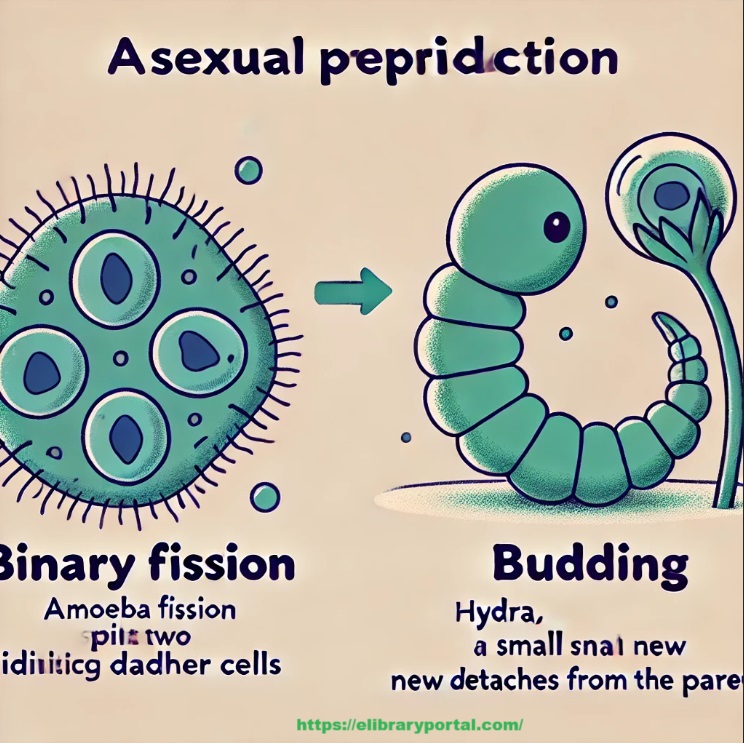Asexual Reproduction
Asexual reproduction is a type of reproduction that involves a single parent and does not require the fusion of gametes. The offspring produced are genetically identical to the parent, known as clones. This process is common in many unicellular organisms, lower plants, and some animals.
Key Features of Asexual Reproduction:
- Single Parent Involvement: Only one organism is involved.
- No Gamete Formation: There is no formation or fusion of male and female gametes.
- Genetic Uniformity: Offspring are clones of the parent, meaning they have identical genetic material.
- Rapid Population Growth: Asexual reproduction often occurs faster than sexual reproduction, allowing for quick population growth.
Methods of Asexual Reproduction:
- Binary Fission:
- Common in unicellular organisms like Amoeba and Paramecium.
- The parent cell divides into two equal-sized daughter cells, each carrying a copy of the parent’s genetic material.
- Budding:
- Seen in organisms like Hydra and Yeast.
- A new individual develops from a small projection (bud) on the parent organism, eventually detaching to live independently.
- Fragmentation:
- Occurs in organisms like spirogyra (algae).
- The parent organism breaks into fragments, and each fragment grows into a new individual.
- Spore Formation:
- Common in fungi and algae.
- Spores, which are reproductive units, are produced by the parent organism and can grow into new individuals under favorable conditions.
An illustration of an Amoeba undergoing binary fission and a Hydra undergoing budding. Let me create an image to show these two forms of asexual reproduction.
See in Fig.

Here is the illustration showing two forms of asexual reproduction: binary fission in Amoeba and budding in Hydra. It highlights how each organism reproduces without involving gametes, producing identical offspring.
15 Questions with Answers and explanations on Asexual Reproduction in Organisms:
1. What is asexual reproduction?
Answer: Asexual reproduction is the process by which a single organism reproduces without the involvement of gametes (sperm and egg). Explanation: In asexual reproduction, the offspring are genetically identical to the parent because there is no fusion of gametes, and only one parent is involved.
2. What is the key difference between asexual and sexual reproduction?
Answer: Asexual reproduction involves a single parent and produces genetically identical offspring, while sexual reproduction involves two parents and produces genetically diverse offspring. Explanation: Sexual reproduction involves the fusion of gametes from two parents, leading to variation, whereas asexual reproduction results in clones of the parent.
3. What is binary fission?
Answer: Binary fission is a form of asexual reproduction where a single organism divides into two identical organisms. Explanation: This process is common in unicellular organisms like bacteria and amoeba, where the parent cell splits into two identical daughter cells.
4. Which organisms commonly use binary fission?
Answer: Bacteria, protists like amoeba and paramecium, and some algae. Explanation: Binary fission is efficient for unicellular organisms as it allows rapid population growth without the need for a mate.
5. What is budding in asexual reproduction?
Answer: Budding is a type of asexual reproduction where a new organism grows as an outgrowth (bud) from the parent organism and eventually detaches to become independent. Explanation: Budding occurs in organisms like yeast, hydra, and some fungi. The bud grows and eventually detaches, creating a clone of the parent.
6. How does budding occur in Hydra?
Answer: In Hydra, a bud develops as an external projection on the body, grows, and detaches to become a new, independent organism. Explanation: The bud is formed through repeated cell divisions at a specific spot on the parent hydra.
7. What is fragmentation?
Answer: Fragmentation is a type of asexual reproduction where an organism breaks into two or more parts, and each part regenerates into a complete organism. Explanation: This process is common in starfish, planaria, and some species of algae. Each fragment regenerates the missing parts to form a new individual.
8. Which organisms reproduce by fragmentation?
Answer: Some species of algae, starfish, and planaria. Explanation: Fragmentation allows these organisms to regenerate lost parts, which is useful for both reproduction and survival.
9. What is spore formation?
Answer: Spore formation is a type of asexual reproduction where an organism produces spores that can grow into new individuals. Explanation: Spores are usually produced in large numbers and are dispersed by wind or water. Organisms like fungi, algae, and some plants use spore formation.
10. What are spores?
Answer: Spores are tiny, usually single-celled reproductive units that can develop into a new organism. Explanation: Spores are highly resistant to harsh conditions and can remain dormant until conditions are favorable for growth.
11. What is vegetative propagation?
Answer: Vegetative propagation is a form of asexual reproduction in plants where new plants are produced from vegetative parts like roots, stems, or leaves. Explanation: Examples include the growing of new plants from the runners of strawberries, the tubers of potatoes, and the bulbs of onions.
12. Which plants reproduce through vegetative propagation?
Answer: Plants like potatoes (tubers), strawberries (runners), and onions (bulbs). Explanation: In vegetative propagation, parts of the parent plant develop into new plants, leading to rapid growth and the production of clones.
13. What is parthenogenesis?
Answer: Parthenogenesis is a form of asexual reproduction where an embryo develops from an unfertilized egg. Explanation: This process occurs in some insects, reptiles, and fish, where females produce offspring without mating.
14. How does regeneration differ from fragmentation?
Answer: Regeneration refers to the ability of an organism to regrow lost parts, whereas fragmentation is when an organism breaks into parts, and each part regenerates into a new organism. Explanation: In regeneration (like in lizards), the lost part grows back, but it doesn’t always lead to new individuals, whereas in fragmentation, each part can form a new individual.
15. What are the advantages of asexual reproduction?
Answer: Asexual reproduction is faster, requires only one parent, and produces large numbers of offspring in a short time. Explanation: Since only one parent is involved, asexual reproduction is efficient, especially in stable environments where genetic variation is not as crucial for survival.






